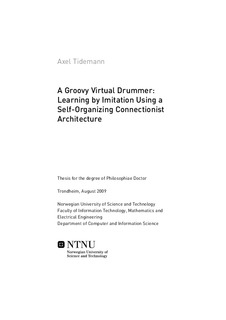| dc.contributor.author | Tidemann, Axel | nb_NO |
| dc.date.accessioned | 2014-12-19T13:30:31Z | |
| dc.date.available | 2014-12-19T13:30:31Z | |
| dc.date.created | 2009-11-13 | nb_NO |
| dc.date.issued | 2009 | nb_NO |
| dc.identifier | 277556 | nb_NO |
| dc.identifier.isbn | 978-82-471-1734-7 (printed ver.) | nb_NO |
| dc.identifier.isbn | 978-82-471-1735-4 (electronic ver.) | nb_NO |
| dc.identifier.uri | http://hdl.handle.net/11250/250002 | |
| dc.description.abstract | The research in this thesis aims to enable robots to imitate humans. Learning by imitation is a fundamental part of human behaviour, since it allows humans to acquire motor skills simply by demonstration; seen from a robotic viewpoint you can easily “program” your fellow humans by showing them what to do. Would it not be great if the same mechanism could be used to program robots? A robot is programmed by specifying the torque of its motors. The torque can be regarded as the force or strength that is the result of muscles contracting or relaxing. Typical approaches to determine motor torques that will lead to a desired behaviour include setting them manually, i.e. on a trial-and-error basis, or specifying them by mathematical equations. Neither of these are intuitive to most humans, so most robot behaviours are programmed by engineers. However, if an engineer was to design a preprogrammed housekeeping robot, it would be very hard to program all the possible behaviours the robot could be expected to perform, even in such a limited domain. It is much more cost-efficient to make the robot learn what to do. This would allow the robot to adapt to its human owner, and not the other way around. Since humans easily learn new behaviours by imitating others, it would be ideal if humans could use the same technique to transfer motor knowledge to robots. I believe research in this area could be of great help to bridge the human-robot interaction gap that currently exists, so that you could have truly intelligent robots that could assist people in everyday life.
To understand imitation learning, knowledge of psychology and neuroscience is required. The research in this thesis has taken an interdisciplinary approach, studying the desired mechanism on both a behavioural and neuroscientific level. I have focused on imitation in a musical setting. The system can both see and hear, and seeks to imitate the perceived behaviour. The application has been to create an intelligent virtual drummer, that imitates both the physical playing style (i.e. the movement of the arms) as well as the musical playing style (i.e. the groove) of the teacher. The virtual drummer will then both look and sound like a human drummer. The research in this thesis presents a multi-modal architecture for imitation of human movements. I have been working on simulated robots due to limits of time and money, however the principles of my research have been developed in a platformindependent way, so it should be applicable to real robots as well. | nb_NO |
| dc.language | eng | nb_NO |
| dc.publisher | Norges teknisk-naturvitenskapelige universitet, Fakultet for informasjonsteknologi, matematikk og elektroteknikk, Institutt for datateknikk og informasjonsvitenskap | nb_NO |
| dc.relation.ispartofseries | Doktoravhandlinger ved NTNU, 1503-8181; 2009:171 | nb_NO |
| dc.title | A Groovy Virtual Drummer:Learning by Imitation Using a Self-Organizing Connectionist Architecture | nb_NO |
| dc.type | Doctoral thesis | nb_NO |
| dc.contributor.department | Norges teknisk-naturvitenskapelige universitet, Fakultet for informasjonsteknologi, matematikk og elektroteknikk, Institutt for datateknikk og informasjonsvitenskap | nb_NO |
| dc.description.degree | PhD i informasjons- og kommunikasjonsteknologi | nb_NO |
| dc.description.degree | PhD in Information and Communications Technology | en_GB |

